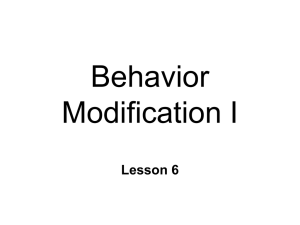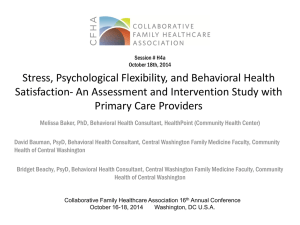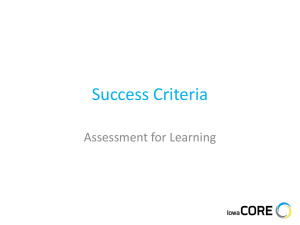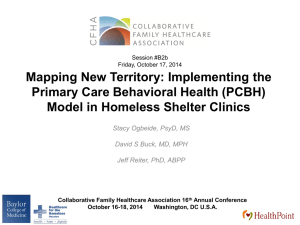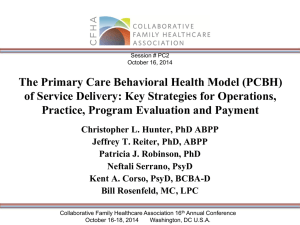Getting Started in Primary Care Behavioral Health
advertisement
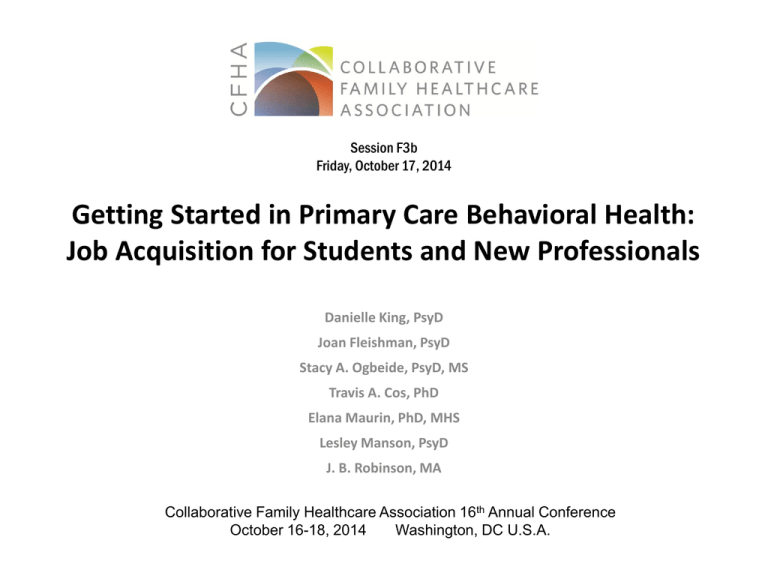
Session F3b Friday, October 17, 2014 Getting Started in Primary Care Behavioral Health: Job Acquisition for Students and New Professionals Danielle King, PsyD Joan Fleishman, PsyD Stacy A. Ogbeide, PsyD, MS Travis A. Cos, PhD Elana Maurin, PhD, MHS Lesley Manson, PsyD J. B. Robinson, MA Collaborative Family Healthcare Association 16th Annual Conference October 16-18, 2014 Washington, DC U.S.A. Faculty Disclosure • We have not had any relevant financial relationships during the past 12 months. Learning Objectives At the conclusion of this session, the participant will be able to: Learning Objective #1 • Identify pathways for finding Primary Care Behavioral Health (PCBH) positions Learning Objective #2 • Discuss helpful approaches to interviewing for a PCBH position Learning Objective #3 • Describe the components of an effective Primary Care Behavioral Health program proposal References Fisher, L. & Dickinson, W.F. (2014). Psychology and primary care: New collaborations for providing effective care for adults with chronic health conditions. American Psychologist, 69, 355-363. Hunter, C. L., & Goodie, J. L. (2012). Behavioral health in the Department of Defense Patient-Centered Medical Home: History, finance, policy, work force development, and evaluation. Translational Behavioral Medicine, 2, 355-363. doi:10.1007/s13142-012-0142-7 Hunter, C. L., Goodie, J. L., Oordt, M. S., & Dobmeyer, A. C. (2009). Building an integrated primary care service. In C. Hunter, J. Goodie, M. Oordt, & A. Dobmeyer (Eds.), Integrated behavioral health in primary care: Step-by-step guidance for assessment and intervention (pp. 11-20). Washington, DC: American Psychological Association. Miller, B. F., Brown Levey, S. M., Payne-Murphy, J. C., & Kwan, B. M. (2014). Outlining the Scope of Behavioral Health Practice in Integrated Primary Care: Dispelling the Myth of the One-Trick Mental Health Pony. References O’Donohue, W.T., & James, L.C. (2009). The primary care toolkit. Practical resources for the integrated behavioral care provider. New York, NY: Springer Publishing. Robinson, P., & Strosahl. K. (2009). Behavioral health consultation and primary care: Lessons Learned. Journal of Clinical Psychology in Medical Settings, 16, 58-71. doi:10.1007/s10880-009-9145-z Robinson, P., & Reiter, J. (2007). Behavioral Consultation and Primary Care A guide to integrating services. New York, NY: Springer Publishing Company, LLC. Runyan, C., Robinson, P., Gould, D. A. (2013). Ethical issues facing providers in collaborative primary care settings: Do current guidelines suffice to guide the future of team based primary care? Families, Systems, & Health, 31, 1-8. doi:10.1037/a0031895 Weisberg, R. B. & Magidson, J. F. (2014). Integrating cognitive behavioral therapy into primary care. Cognitive and Behavioral Practice, 21, 247-251. Learning Assessment • A learning assessment is required for CE credit. • A question and answer period will be conducted at the end of this presentation. Pathways into the Workforce Informal • Professional Organizations and Conferences – – – – Collaborative Family Healthcare Association Division 38 (Health Psychology) of APA Society of Behavioral Medicine American Academy of Family Physicians • Local Networking – Physician Networking Groups and/or Events – Local Professional Associations – LinkedIn Professional Networks Introduce yourself, ask for a card, and FOLLOW UP! Pathways into the Workforce Formal • Employment Listings and Websites – – – – Indeed.com, Monster.com, Careerbuilder.com, etc. Association Newsletters/Websites Dept of Veterans Affairs Jobs Website Local Employer Job Postings • Professional Listserves – Collaborative Family Healthcare Association – Division 38 (Health Psychology) of APA – Society of Behavioral Medicine Seek out opportunities within your own organizations! Skills to Highlight: Training & Experience • Systems-oriented approach • Knowledge related to: – Various treatment modalities – Behavioral and medical disorders – Psychotropic meds (not required, but a plus) • Consultation/liaison skills • SO, any health/peds psych experience should be highly emphasized Skills to Highlight: Personal Characteristics • • • • • Flexibility Adaptability Enthusiasm Openness Availability What are they looking for? BASICS • Licensure/ Licensure-Eligible • Goodness-of-Fit – Personality fit with the job: “self-starter,” organized, energetic, motivated, stable, efficient, stable – Personality fit with the team: flexible, good “team player”, not “trying to be the star of the team,” fits needs – Population-served by the medical setting: cultural competence, appropriate experience, demonstrated motivation to learn more about local community What are they looking for? • Knowledge – Clinical experience, Health-Related knowledge, “Homework” related to Familiarity with PCBH Model & Integrated Care • Communication Skills – Can you demonstrate you can effectively and briefly communicate ideas/information – Ability to be a resource/ effective educator for providers, staff, and patients – Conflict resolution and address difficult subjects What are they looking for? • Skill Competence – Brief screening/assessment, Brief interventions, “How can you help the providers,” EBTs, Motivational Interviewing – Adaptability, ethics, & critical thinking • Demonstrated Performance – Be prepared for panel interview, clinical vignettes, and to share your own clinical experiences. • Intangibles – How can you help the clinic’s specific needs. Questions to Ask Your Potential Employer – If possible, ask a mentor who works in an integrated PCBH model for feedback and potential questions – Job description – Salary – Position funding Robinson & Strosahl, 2009 Questions to Ask Your Potential Employer – What do they want from you? • • • • • Clinical? Teaching? Research? Advocacy? All of the above? – Are your professional goals consistent with the position? – Goals for PCBH implementation Hunter & Goodie, 2012; Hunter et al., 2009 Questions to Ask Your Potential Employer – – – – Patient population? High acuity? Number of providers per clinic session Number of patients seen per clinic session Other integrated (or co-located) services on site? • Referral process to other services – – – – – Staff training? Training for you? Billing? EHR? BHC location? (the closer, the better) Developing New Positions • Finding an Organization – State Primary Care Association – National Health Service Corp – SAMHSA/HRSA – Networking – Google! Developing New Positions • Researching an Organization – Mission of the organization – Stakeholders within the organization – Size of the organization – Current clinical programs – State and county reimbursement structure – Integration Programs in the Surrounding Area Developing New Positions • Contacting an Organization – A Tale of Two Cover Letters • Case Study One • Case Study Two Program Proposal: Development • • • • • • • Know your audience and key stakeholders Introduce evidence for the model Develop aims from practice specific needs Promote clinical role Understand organizational structure Address implementation plan Address financial viability and sustainability – Direct Revenue Program Proposal: Development • Business case for BH – Indirect value – Patient satisfaction – PCMH – Team based care • Show them the numbers – Cost offset – Increase access – Population Mgmt – Employee Wellness – “Buy In” • Anticipate questions and concerns Program Proposal: The Pitch • • • • • • Get buy in for integrated model Promote clinical role Highlight evidence for value added model Address implementation plan Address financial viability and sustainability Anticipate questions and concerns Session Evaluation Please complete and return the evaluation form to the classroom monitor before leaving this session. Thank you!


